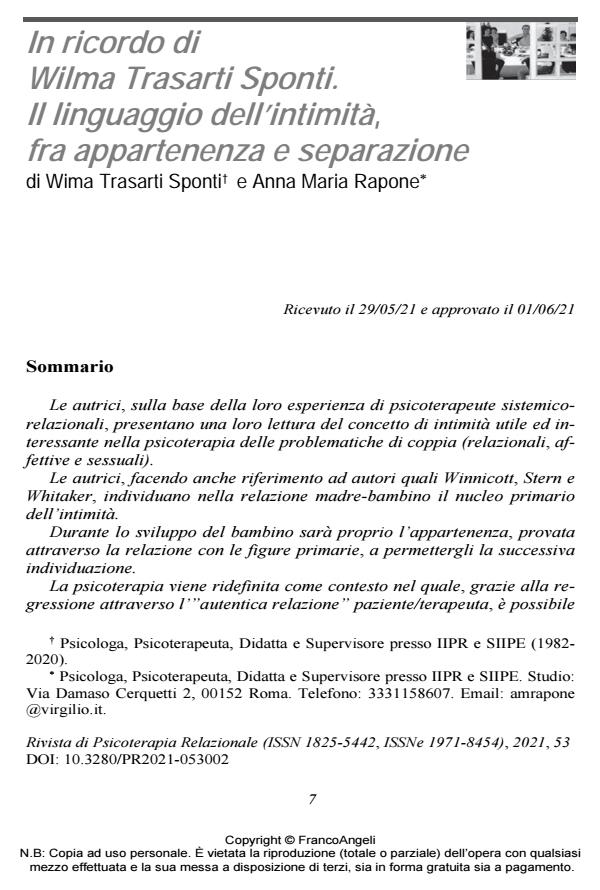The secret language of intimacy between belonging and individuation.
Journal title RIVISTA DI PSICOTERAPIA RELAZIONALE
Author/s Wima Trasarti Sponti, Anna Maria Rapone
Publishing Year 2021 Issue 2021/53
Language Italian Pages 19 P. 7-25 File size 223 KB
DOI 10.3280/PR2021-053002
DOI is like a bar code for intellectual property: to have more infomation
click here
Below, you can see the article first page
If you want to buy this article in PDF format, you can do it, following the instructions to buy download credits

FrancoAngeli is member of Publishers International Linking Association, Inc (PILA), a not-for-profit association which run the CrossRef service enabling links to and from online scholarly content.
The author, present their concept of intimacy which proved to be of great interest and help in psychotherapy of couples problems (rela-tional, emotional and sexual). They experienced and utilized in their clinical work as systemicrelational psychotherapists. The authors, referring also to Winnicot, Stern, and Whitake, indi-viduate in the primitive "mother-child" relationship the nucleus of in-timacy. The child while experiencing belongings with mother and other rel-evant figures will then develop the capacity of safely individuating. They then define psychotherapy as a context in which the patients can experience regression and recognize their needs thanks to the honest authentic patient/psychotherapist relationship. The therapist "sufficiently good" will act as facilitator to activate or re-activate pa-tients resources. During couple psychotherapy the authors take into account the multigenerational story of patients and its development and analyze and utilize the nostalgia of primitive belonging together with the actual shame and uncertainty of recovering it. Finally they suggest that the concept of "struggle of power" so of-ten present in couples problems solving might be a poor shelter cover-ing deeper needs looked for in a couple relationship.
Keywords: belonging, individuation, intimacy, relationship, shame, systemic-relational couple therapy.
- Darwin C. (1872). The Expression of Emotions in Man and animals. London: J. Murray (trad. it.: L’espressione delle emozioni. Torino: Bollati Boringhieri, 1982).
- Ducci G. (2000). La relazione terapeutica in ipnosi. In: Loriedo C. e Santilli W., a cura di, La relazione terapeutica. Milano: Franco Angeli.
- Ducci G., Casilli C. (2002). La supervisione della nuova ipnosi. Milano: Franco Angeli.
- Erickson M.H., Rossi E.L. Opere. Volume I (1982), II (1983), III (1983), IV (1984). Roma: Astrolabio.
- Gallese V., Migone P., Eagle M.N. (2006). La simulazione incarnata: i neuroni specchio, le basi neurofisiologiche dell’intersoggettività ed alcune implicazioni per la psicoanalisi. Psicoterapia e Scienze Umane, 3: 543-544.
- Holmes J. (1994). La teoria dell’attaccamento. John Bowlby e la sua scuola. Milano: Raffaello Cortina.
- Holmes J. (2004). Psicoterapia per una base sicura. Milano: Raffaello Cortina.
- Lee R. (1995). Gestalt and Shame. The Foundation for a Clearer Understanding of Field Dynamic. The British Gestalt Journal, 4, 1: 14-22.
- Lee R. (2009). Il linguaggio segreto dell’intimità. Milano: Franco Angeli.
- Liotti G. (1992). Disorganizzazione dell’attaccamento e predisposizione allo sviluppo di disturbi funzionali della coscienza. In Ammanniti M., Stern D.N., a cura di, Attaccamento e psicoanalisi. Bari: Laterza.
- Loriedo C. (1978). Terapia relazionale, Roma: Astrolabio.
- Loriedo C., Santilli W., a cura di (2000). La relazione terapeutica. Milano: Franco Angeli.
- Loriedo C. (2002). Dall’attaccamento al sistema. Milano: Franco Angeli.
- Loriedo C., Del Castello E., a cura di (1995). Tecniche dirette e indirette in ipnosi e in psicoterapia. Milano: Franco Angeli.
- Maturana H., Varela F. (1980). Autopoiesi e cognizione. Roma: Astrolabio.
- Maturana H., Varela F. (1987). L’albero della conoscenza. Milano: Garzanti Edizioni.
- Prigogine I. (1985). L’esplorazione della complessità. In: Bocchi G. e Ceruti M., La sfida della complessità. Milano: Feltrinelli.
- Stern D.N. (1987). Il mondo interpersonale del bambino. Torino: Bollati Boringhieri.
- Solfaroli Camillocci D. (2010). Up and Down. Solitudine e potere di coppia. Milano: Franco Angeli.
- Tomkins S.S. (1963). Effect Imagery, and Consciousness: The Negative Affects. Vol. 2. New York: Springer.
- Trasarti Sponti W., Rapone A.M. (2009). Come utilizzare una diga. Le minimal cues bilaterali. In: Valerio C. e Mammini C., a cura di. L’evoluzione clinica dell’ipnosi. Milano: Franco Angeli.
- Trasarti Sponti W., Rapone A.M. (2011). Una tecnica incarnata nella formazione del setting e nella convocazione: Il Modello Congiunto-Disgiunto nel trattamento delle famiglie DCA. In: Chianura P., Chianura L., Fuxa E., Mazzoni S. (a cura di), Manuale Clinico di Terapia Familiare, vol I. Milano: Franco Angeli.
- Von Foerster H. (1987). Sistemi che si osservano. Roma: Astrolabio.
- Whitaker C.A. (1984). Il gioco e l’assurdo, La terapia esperienziale della famiglia. In Vella G., Trasarti Sponti W., a cura di op. cit., Roma: Astrolabio.
- Whitaker C.A. (1990). Considerazioni notturne di un terapeuta della famiglia. Roma: Astrolabio.
Wima Trasarti Sponti, Anna Maria Rapone, In ricordo di Wilma Trasarti Sponti. Il linguaggio dell’intimità, fra appartenenza e separazione in "RIVISTA DI PSICOTERAPIA RELAZIONALE " 53/2021, pp 7-25, DOI: 10.3280/PR2021-053002